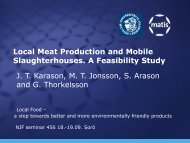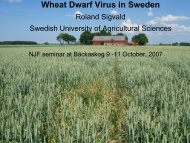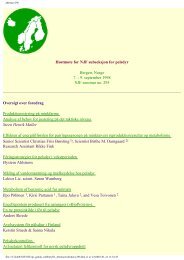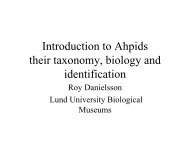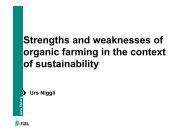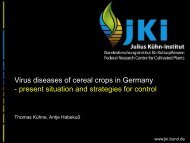measurement methods of soil, water, plant and fruit, in berry ... - NJF
measurement methods of soil, water, plant and fruit, in berry ... - NJF
measurement methods of soil, water, plant and fruit, in berry ... - NJF
Create successful ePaper yourself
Turn your PDF publications into a flip-book with our unique Google optimized e-Paper software.
Pect<strong>in</strong>s <strong>in</strong> AIS<br />
The AIS conta<strong>in</strong>ed <strong>in</strong> average 26 g/100 g dry weight acid extractable pect<strong>in</strong>s, correspond<strong>in</strong>g<br />
to a content <strong>in</strong> the <strong>fruit</strong> <strong>of</strong> 0.9 g pect<strong>in</strong>s/100 g fresh weight or 11 g pect<strong>in</strong>s/100 g dry weight.<br />
The range noticed among the genotypes (23.0–30.4 g/100 g dry weight) is large <strong>and</strong> should<br />
make it possible to improve yield through selection <strong>of</strong> genotypes with high content <strong>of</strong> pectic<br />
substances.<br />
UA <strong>and</strong> GalA <strong>in</strong> pect<strong>in</strong>s<br />
There was a significant difference between the <strong>methods</strong> for UA/GalA estimates <strong>in</strong> pect<strong>in</strong>s but<br />
no significant <strong>in</strong>teraction between genotype <strong>and</strong> method. Thus anyone <strong>of</strong> the two <strong>methods</strong><br />
could be used to estimate uronic acids <strong>in</strong> pect<strong>in</strong>s.<br />
In pect<strong>in</strong>s, the content <strong>of</strong> UA was <strong>in</strong> average 63% dw, <strong>and</strong> the content <strong>of</strong> GalA 57% dw. The<br />
reason for the higher estimates obta<strong>in</strong>ed by the colorimetric method (about 10%) may be that<br />
the used enzymes were not able to completely degrade the pect<strong>in</strong>s (Massiot <strong>and</strong> Renard<br />
1997).<br />
GalA <strong>in</strong> <strong>fruit</strong>s<br />
The comb<strong>in</strong>ed enzymatic/HPLC method revealed significant differences between genotypes<br />
<strong>in</strong> content <strong>of</strong> GalA when homogenized frozen <strong>fruit</strong> samples were analysed. The rank<strong>in</strong>g <strong>of</strong> the<br />
genotypes was consistent regardless <strong>of</strong> whether fresh weight or dry weight estimates were<br />
used. Furthermore, the rank<strong>in</strong>g <strong>of</strong> genotypes was also consistent with the rank<strong>in</strong>g <strong>of</strong><br />
genotypes based on content <strong>of</strong> acid extractable pect<strong>in</strong>s.<br />
Correlations<br />
Between content <strong>of</strong> GalA <strong>in</strong> <strong>fruit</strong>s estimated by the comb<strong>in</strong>ed enzymatic/HPLC method, <strong>and</strong><br />
content <strong>of</strong> acid extracted pect<strong>in</strong>s, a high correlation (R=0.89) was obta<strong>in</strong>ed based on dry<br />
weight. Between estimates based on fresh weight an even higher correlation was obta<strong>in</strong>ed<br />
(R=0.93). UA were not assayed colorimetrically <strong>in</strong> fresh <strong>fruit</strong> samples because <strong>of</strong> the presence<br />
<strong>of</strong> <strong>in</strong>terfer<strong>in</strong>g compounds which exclude the colorimetric approach. By contrast, the comb<strong>in</strong>ed<br />
enzymatic/HPLC method is most useful for this purpose. At the same time other important<br />
organic acids like malic <strong>and</strong> succ<strong>in</strong>ic acids can be analysed with this method, thus enabl<strong>in</strong>g<br />
detection <strong>of</strong> multiple compounds <strong>and</strong> reduc<strong>in</strong>g screen<strong>in</strong>g costs.<br />
Selection <strong>of</strong> a proper column for HPLC separation is most important. The Am<strong>in</strong>ex HPX-87H<br />
column produces highly reproducible results, can be used for years with limited ma<strong>in</strong>tenance<br />
<strong>and</strong> provides good separation for a range <strong>of</strong> compounds. However, the Am<strong>in</strong>ex HPX-87H<br />
column has one drawback: citric acid elutes close with GalA, which may cause problem if this<br />
compound is present <strong>in</strong> detectable amount. This problem could be avoided by use <strong>of</strong> another<br />
analytical column.<br />
It would be <strong>in</strong>terest<strong>in</strong>g to validate the comparatively easy <strong>and</strong> fast enzymatic/HPLC method<br />
for analysis <strong>of</strong> other raw materials, e.g. apple. In case <strong>of</strong> apples, there is no reason why the<br />
comb<strong>in</strong>ed enzymatic <strong>and</strong> HPLC method shouldn’t work, s<strong>in</strong>ce it has been shown that pect<strong>in</strong>s<br />
<strong>in</strong> Japanese qu<strong>in</strong>ce are very similar to pect<strong>in</strong>s <strong>in</strong> apples.<br />
Acknowledgements<br />
I thank Dr Maud Thomas, Dr Jean-Francois Thibault <strong>and</strong> Nancy Badilas, INRA, Nantes, who<br />
made the validation <strong>of</strong> the comb<strong>in</strong>ed enzymatic <strong>and</strong> HPLC method possible, <strong>in</strong> a <strong>fruit</strong>ful cooperation.<br />
The cited study was carried out with f<strong>in</strong>ancial support from the Commission <strong>of</strong> the<br />
European Communities, Agriculture <strong>and</strong> Fisheries (FAIR) specific RTD programme, CT 97-<br />
3894, ’Japanese qu<strong>in</strong>ce (Chaenomeles japonica) - a new European <strong>fruit</strong> crop for production <strong>of</strong><br />
juice, flavour <strong>and</strong> fibre’. It does not necessarily reflect its views <strong>and</strong> <strong>in</strong> no way anticipates the<br />
Commission’s future policy <strong>in</strong> this area.



